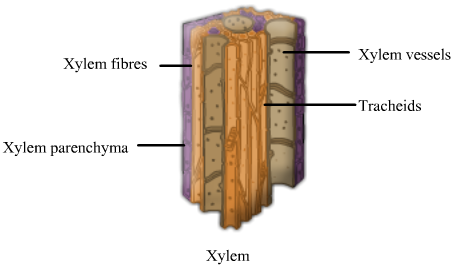
The solution of water and minerals absorbed by the roots move upward to the other parts of the plant through
A) Phloem
B) Xylem
C) Cambium
D) None of the above
Answer
556.8k+ views
Hint: In the vascular plant, it is one type of transport tissue whose main function is to transport water from roots to stems and leaves, but it also transports nutrients. It also provides mechanical support and storage to the plant.
Complete answer:
- Plant vascular tissue that is xylem transports water and the nutrients from the root to the other parts of the plant. Physical support to the plant is also provided by them.
- Tracheary elements are the specialized water-conducting cells present in the tissue of the xylem that with the phloem helps in conducting the sugar from the leaves to the rest of the plant.
- In all the vascular plants, xylem is found. For example seedless club mosses, ferns, horsetails, all the flowering plants that are angiosperms, and all the plants with seeds unenclosed in an ovary that is gymnosperms.
- The rate of conduction of water is increased with the increase in the rate of transpiration. Hence, conduction is unidirectional.
- Beginning of the formation of xylem starts with the actively dividing cells of the growing root and show tips and give rise to primary xylem
Additional information:
Phloem: it helps in the transportation and distribution of organic nutrients. It also provides the pathway for the signaling molecules and in the plant body it performs various structural functions

Cambium: In many seed-bearing plants it is a cylindrical layer of tissue in the stems and roots whose cells divide very fast and forms a new layer of tissue.
- It is a kind of meristematic tissue and most active in the woody plants and generally present between the bark and wood of the stem.
So, the correct answer is, option (B) “Xylem”.
Note:
- The transportation of water and some soluble nutrients like minerals and inorganic ions, upwards from the roots to the rest of the plant performed by the xylem.
- Protoxylem is the first xylem that develops in a growing plant and narrow vessels are present due to the small size of the plant and later development of matter xylem takes place and contains larger vessels and cells.
Complete answer:
- Plant vascular tissue that is xylem transports water and the nutrients from the root to the other parts of the plant. Physical support to the plant is also provided by them.
- Tracheary elements are the specialized water-conducting cells present in the tissue of the xylem that with the phloem helps in conducting the sugar from the leaves to the rest of the plant.
- In all the vascular plants, xylem is found. For example seedless club mosses, ferns, horsetails, all the flowering plants that are angiosperms, and all the plants with seeds unenclosed in an ovary that is gymnosperms.
- The rate of conduction of water is increased with the increase in the rate of transpiration. Hence, conduction is unidirectional.
- Beginning of the formation of xylem starts with the actively dividing cells of the growing root and show tips and give rise to primary xylem
Additional information:
Phloem: it helps in the transportation and distribution of organic nutrients. It also provides the pathway for the signaling molecules and in the plant body it performs various structural functions

Cambium: In many seed-bearing plants it is a cylindrical layer of tissue in the stems and roots whose cells divide very fast and forms a new layer of tissue.
- It is a kind of meristematic tissue and most active in the woody plants and generally present between the bark and wood of the stem.
So, the correct answer is, option (B) “Xylem”.
Note:
- The transportation of water and some soluble nutrients like minerals and inorganic ions, upwards from the roots to the rest of the plant performed by the xylem.
- Protoxylem is the first xylem that develops in a growing plant and narrow vessels are present due to the small size of the plant and later development of matter xylem takes place and contains larger vessels and cells.
Recently Updated Pages
Master Class 11 Business Studies: Engaging Questions & Answers for Success

Master Class 11 English: Engaging Questions & Answers for Success

Master Class 11 Computer Science: Engaging Questions & Answers for Success

Master Class 11 Social Science: Engaging Questions & Answers for Success

Master Class 11 Maths: Engaging Questions & Answers for Success

Master Class 11 Biology: Engaging Questions & Answers for Success

Trending doubts
Differentiate between an exothermic and an endothermic class 11 chemistry CBSE

10 examples of friction in our daily life

One Metric ton is equal to kg A 10000 B 1000 C 100 class 11 physics CBSE

Difference Between Prokaryotic Cells and Eukaryotic Cells

State the laws of reflection of light

Explain zero factorial class 11 maths CBSE




